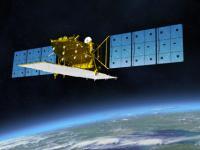ALOS-2 (Advanced Land Observation Satellite 2) is the follow-on JAXA L-SAR satellite mission of ALOS (Daichi) approved by the Japanese government in late 2008. The overall objective is to provide data continuity to be used for cartography, regional observation, disaster monitoring, and environmental monitoring.
The post-ALOS program of JAXA has the goal to continue the ALOS (nicknamed Daichi) data utilization - consisting of ALOS-2 (SAR satellite) and ALOS-3 (optical satellite) in accordance with Japan's new space program.
The state-of-the-art L-band Synthetic Aperture Radar (SAR) aboard ALOS-2, which is an active microwave radar using the 1.2 GHz frequency range, which, in responding to society's needs, has enhanced performance. The SAR is capable of observing day and night, and in all weather conditions.
ALOS-2 has a spotlight mode (1 to 3 m) and a high resolution mode (3 to 10 m). It allows comprehensive monitoring of disasters by providing users with more detailed data. The observation frequency of ALOS-2 is improved by greatly expanding the observable range of the satellite up to about 3 times, through an improvement in observable areas (from 870 km to 2,320 km), as well as giving ALOS-2 a right-and-left looking function.
Instruments:
PALSAR-2 (Phased Array type L-band Synthetic Aperture Radar-2)
CIRC (Compact InfraRed Camera)
